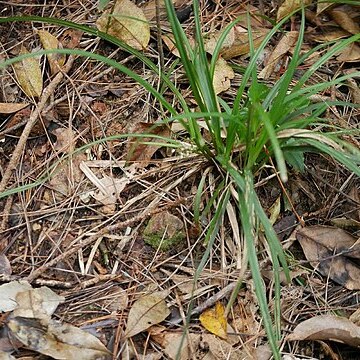Rhizome short, cespitose. Stems central, sometimes more stems together, more or less hidden amongst the leaves, suberect, triquetrous, smooth, 5-20(-30) cm by c. 1 mm. Leaves basal, very much longer than the stems, flat, long-acuminate, scabrid on the margins and upper surface, 3-6(-8) mm wide; lower leaves reduced to bladeless brown sheaths or their fibrous remains. Spikelets usually 5-7, single at the nodes, erect or suberect, cylindric, lax-flowered, lower ones somewhat distant; terminal spikelet male, 1-2 cm long, 1 mm thick, often overtopped by some of the female spikelets; lateral spikelets female or with some male flowers at the top, 1-3 cm by 3-4 mm; peduncles scaberulous, lower ones exserted. Lower bracts foliaceous, much exceeding the inflorescence, shortly sheathing, upper much reduced. Glumes broadly ovate to oblong-ovate, usually rounded at the erose apex, much shorter than the utricles, slenderly nerved, with not or slightly (up to 1 mm) excurrent midnerve and hyaline margins, ciliolate, 2-3 mm long. Utricles rhomboid-lageniform, trigonous, broadest about the middle, subcoriaceous, straight, suberect, strongly multinerved, glabrous or sparsely puberulous above, stramineous or greenish, stipitate, 3.5-4.5 by 1.25-1.5 mm; beak hispid, bidenticulate, 0.5-1 mm long. Nut narrowly rhomboid, triquetrous with concave faces, stipitate, truncate and hollowed out at the apex, dark brown with pale stipe, apex, and angles, 2.25-3 by 1.25-1.5 mm. Style-base slightly thickened. Stigmas 3.
More
Rhizome short. Culms 10-20 cm tall, trigonous. Basal sheaths dark brown, split into fibers. Leaves longer than culm, blades 4-7 mm wide, flat, smooth, leathery. Involucral bracts leafy, much longer than inflorescence, sheathed. Inflorescence 3-5-noded; spikes many, 3-5 at each node; terminal spike male, linear, 17-45 × 1-1.5 mm, shortly pedunculate; lateral spikes female or mostly with male part at apex, narrowly cylindric, 3-4.5 cm, ca. 3 mm thick, subloosely flowered, sessile or shortly pedunculate. Female glumes ovate-oblong, 2.5-3 mm, ciliate, apex rounded. Utricles green, longer than glume, rhombic-fusiform, trigonous, 3.5-5 mm, membranous, many veined, glabrous or puberulent above, base cuneate, stipitate, apex gradually attenuate into a conic beak, beak ca. 1 mm, 2-toothed at orifice. Nutlet brown to dark brown, tightly enveloped, rhombic, trigonous, 2.5-3 mm, faces excavated in both upper and lower parts, base cuneate, shortly stipitate, apex with distinct short neck ca. 0.3 mm, neck shallowly concave at top, neck and angles yellowish white; style base slightly thickened; stigmas 3. Fl. winter, fr. next spring.

